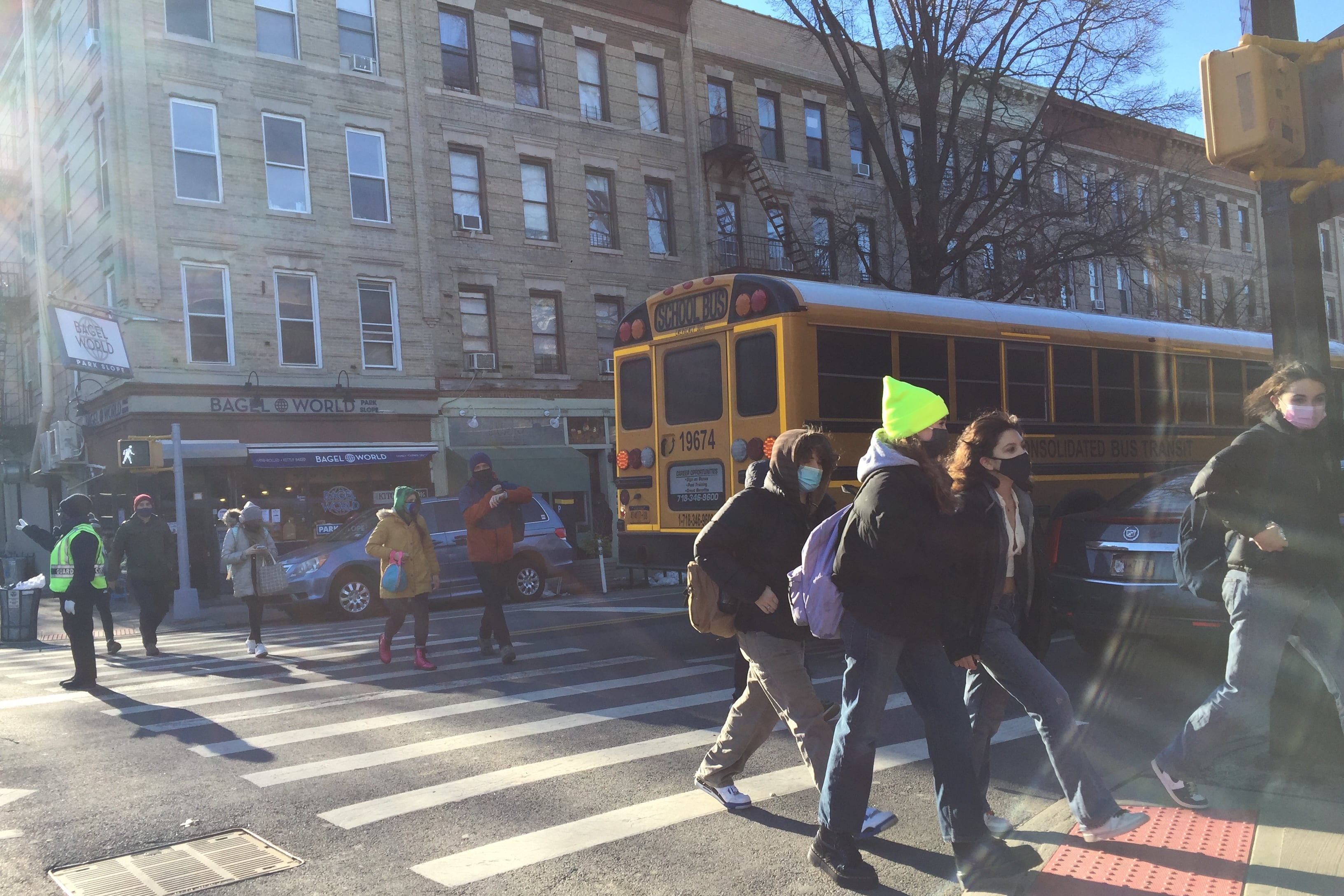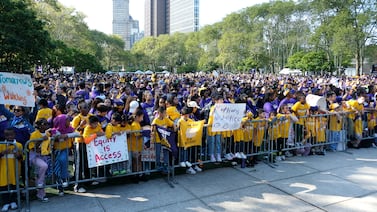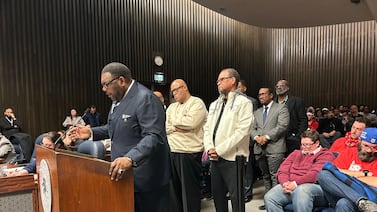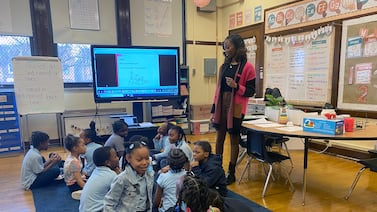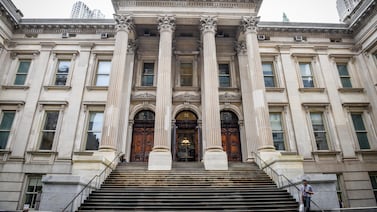Chalkbeat is a nonprofit news organization covering public education in communities across America. Sign up for our free New York newsletter to keep up with NYC’s public schools.
New York City’s eighth graders were awash in jitters and excitement Thursday as they awaited their long-anticipated high school admissions offers.
The annual rite of passage for the city’s 13-year-olds caps a notoriously complex, monthslong application process that requires students to select 12 top choices from a list of over 400 high schools across the city.
Thursday’s notifications arrived three months earlier than they did last year, as part of a series of reforms under schools Chancellor David Banks meant to simplify the process and tighten access to some coveted selective schools.
The city’s education department didn’t immediately release data on the percentage of students who received their top choices, or the demographics of students admitted to the most competitive screened schools, which have historically enrolled disproportionately small shares of Black, Latino, and low-income students. Offers to the city’s specialized high schools, which use a separate admissions process based on a single test, were also sent to families Thursday, but officials didn’t immediately share acceptance data.
Paulette Healy, the mom of an eighth grader in Brooklyn, spent much of her day “anxiously refreshing” her MySchools account to see if offers had been posted. The notifications eventually arrived in families’ accounts around 4:30 p.m., and Healy found out her daughter got matched with her second choice school, the Digital Arts and Cinema Technology High School.
“She is excited,” Healy said. “She and her group of friends have been texting back and forth…There are some that are celebrating, some that are lamenting.”
At Urban Assembly Institute for Math and Science for Young Women, a school with grades 6-12 in Downtown Brooklyn, students were a bundle of nerves and joy as they awaited high school decisions.
“It’s mostly a fun day for folks,” said Jen Cusa, the school’s director of culture, who oversees admissions, but “sometimes they’re really sad.” The school had at least one moment of pure happiness when two close friends, who got early notice they’d be attending the same high school next year, locked arms in a caught-on-camera hug.
Some families experienced frustrating technical glitches that delayed their notifications, while others got a sneak peek at the results when offers were briefly mistakenly posted online Wednesday.
Queens parent Adriana Aviles got a message that the site wasn’t responding when she tried to check. But her frustration quickly turned to relief when she learned her son was accepted to Townsend Harris High School, a selective school in Queens.
New timeline gives families longer to weigh offers
While many features of this year’s high school offer day were familiar, there were also changes stemming from tweaks to the system last fall.
The earlier offer date is part of an effort to move up the timeline to give families longer to weigh their options. Applications opened in October this year and closed Dec. 5, earlier than throughout most of the pandemic, but on par with pre-pandemic timelines.
Healy said she appreciated finding out her daughter’s match earlier in the year, but pointed out that there are also drawbacks to having the application process earlier in the year, when families are still dealing with the start of school, and high schools may have less bandwidth to put out information to families.
“I really feel like the application process this year was way too soon. Even high schools were caught off guard,” Healy said. “That was very chaotic and very stressful for a lot of families.”
The education department also standardized the criteria for qualifying for screened high schools and centralized the calendar for school open houses to make the process more transparent.
Before the pandemic, screened schools were allowed to choose their own criteria —including grades, test scores and attendance for selecting students. Former Mayor Bill de Blasio scrapped that system amid pandemic disruptions, instituting a system where students who scored an average of 85 or above got equal priority at screened schools. That shift drew fierce criticism from families of top-scoring students, who argued their kids were disadvantaged by getting grouped with lower-scoring kids.
For this year’s admissions cycle, Banks opted to keep the group system based on grades, but tightened the score needed to qualify for the top group — a change that significantly narrowed the group of kids with priority access to competitive screened schools.
“If a young person is working their tail off every single day and they get a 99% average … that should be honored,” Banks said at the time. “You should not be thrown in a lottery with just everybody.”
Education department projections from last fall indicated that fewer Black and Hispanic students than last year would likely get priority to the most coveted screened schools, though the numbers would remain higher than before the pandemic.
Burden on schools to market themselves
At the Institute of Math and Science, Cusa felt that this year’s grade groupings — with their strict numerical cutoffs — were helpful for giving students a realistic sense early on of which schools they were likely to get into and which were bigger reaches.
But she added that there are still significant barriers to increasing the representation of low-income students of color in selective schools. For one, patterns of where students apply can be deeply entrenched and difficult to break. The complexity of the admissions process can also favor families with more time and expertise, she said.
“You really see and understand how savvy and connected and aware you really need to be to make a very informed decision,” she said.
The parent advocacy group PLACE NYC, which pushes for more academic screening and accelerated programs, described this year’s changes to screened admissions as an improvement over last year, but said the changes don’t “go far enough,” and pushed for the reintroduction of test scores as an admissions metric.
High schools will begin outreach to students who received offers right away and hold information sessions and virtual events. Students who received multiple offers have until April 5 to accept one.
Students are automatically added to waitlists for schools they ranked higher than the one they were matched with. They can also manually join waitlists for other schools.
Cusa, who also oversees admissions for the Institute of Math and Science’s high school branch, said high schools face significant pressure to retain students who received offers to shore up enrollment, which is tied to funding.
“Now I have to be a marketing campaigner,” she said. “I need to capture these people, and they need to be stoked.“
Michael Elsen-Rooney is a reporter for Chalkbeat New York, covering NYC public schools. Contact Michael at melsen-rooney@chalkbeat.org.

